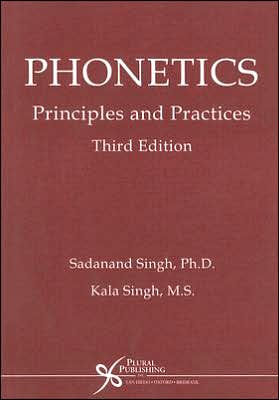Phonetics: Principles and Practices
This fundamental text is a launching point for study in the field of phonetics. It introduces readers to the key elements in phonetic study, providing an overview of phonetic transcription, anatomy of speech production and perception, the physics of sound, properties of vowels, diphthongs, and consonants, stress and intonation, and connected speech. Revisions in this third edition reflect the steady growth in exploration and understanding of the field of phonetics since the publication of the...
Search in google:
This fundamental text is a launching point for study in the field of phonetics. It introduces readers to the key elements in phonetic study, providing an overview of phonetic transcription, anatomy of speech production and perception, the physics of sound, properties of vowels, diphthongs, and consonants, stress and intonation, and connected speech. Revisions in this third edition reflect the steady growth in exploration and understanding of the field of phonetics since the publication of the original edition of this book, with valuable contributions and input from two distinguished phoneticians, Donald Mower, PhD, and David Ingram, PhD In addition to new and updated content, this book retains the unique presentation of selected speech production modules developed over 30 years ago, which enable students to independently study the complex phenomenon of speech sound in context. After mastering this text, students will find they have opened the door to opportunities in the study of speech-language pathology. Doody Review Services Reviewer:Nelda S Richards, Ph.D., CCC-SLP(George Washington University)Description:This introduction to the International Phonetic Alphabet provides an in-depth description of the articulatory, acoustic, and perceptual features of the speech sounds. Previous editions were published in 1976 and 1982.Purpose:The book is intended to provide students in the fields of speech-language pathology and audiology information about the sound system and to teach them how to use the International Phonetic Alphabet to transcribe speech. This is a necessary skill for these professionals and the author succeeds in covering all aspects of phonetics.Audience:It seems to be geared to undergraduate students in speech-language pathology and audiology. The author is a respected authority in this field.Features:The book covers the anatomy of the speech mechanism and introduces the International Phonetic Alphabet and the classification of the sounds. It discusses the branches of phonetic science including perceptual phonetics and covers well the acoustic features of sounds and the science of phonetics. However, it provides limited practice for phonetic transcription.Assessment:This book covers all of the basic areas of phonetics, with excellent descriptions of the acoustic qualities of speech as well as perceptual phonetics. Information about phonological acquisition and development is limited, as is transcription practice. Another book in this area, Fundamentals of Phonetics: A Practical Guide for Students, 2nd edition, by Small (Allyn & Bacon, 2005), provides practice CDs and gives students practice with both adult and child speech, both normal and disordered. It further provides practice with a variety of dialect speakers.
Why we study phonetics. How we study phonetics. The major aspects of the study of phonetics. A description of speech sound production. Acoustics. Perception. Spoken versus written language. Phonetic transcription. Articulators aspects of phonetics: Consonants, Vowels, and Diphthongs. Important. Acoustic Cues to Discriminate Speech Sounds and Speech Perception. . Perception. Syllables, Stress, and Intonation. From Phonetics to Phonology. Additional Sounds Closely Related to English Phonemes. Pronunciation differences and Dialects. Bibliography. Exercises.
\ From The CriticsReviewer: Nelda S Richards, Ph.D., CCC-SLP(George Washington University)\ Description: This introduction to the International Phonetic Alphabet provides an in-depth description of the articulatory, acoustic, and perceptual features of the speech sounds. Previous editions were published in 1976 and 1982.\ Purpose: The book is intended to provide students in the fields of speech-language pathology and audiology information about the sound system and to teach them how to use the International Phonetic Alphabet to transcribe speech. This is a necessary skill for these professionals and the author succeeds in covering all aspects of phonetics.\ Audience: It seems to be geared to undergraduate students in speech-language pathology and audiology. The author is a respected authority in this field.\ Features: The book covers the anatomy of the speech mechanism and introduces the International Phonetic Alphabet and the classification of the sounds. It discusses the branches of phonetic science including perceptual phonetics and covers well the acoustic features of sounds and the science of phonetics. However, it provides limited practice for phonetic transcription.\ Assessment: This book covers all of the basic areas of phonetics, with excellent descriptions of the acoustic qualities of speech as well as perceptual phonetics. Information about phonological acquisition and development is limited, as is transcription practice. Another book in this area, Fundamentals of Phonetics: A Practical Guide for Students, 2nd edition, by Small (Allyn & Bacon, 2005), provides practice CDs and gives students practice with both adult and child speech, both normal and disordered. It further provides practice with a variety of dialect speakers.\ \








